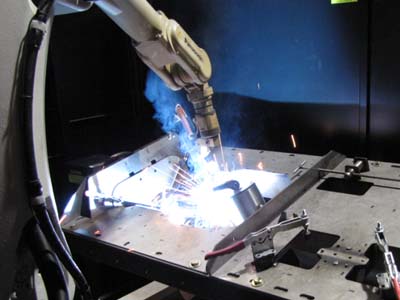Customize Your Process to Increase Productivity
Fixtures are essential to most machining processes and can have a direct impact on productivity, cost and quality. However, the level of efficiency of automation depends upon the design and manufacturing of the fixturing. In fact, according to Assembly Magazine, inappropriate fixtures contribute to 40 percent of rejected parts, so it is important to realize that without proper fixturing to hold parts in the right position and orientation, robots can’t make accurate welds.
The variety of possibilities for a weld’s intended shape, size, and profile requires unique, custom engineered fixturing solutions for each application. Linde can provide many types of fixtures for your automation needs. Depending on the complexity of the part and the level of interface you require, a tool can be designed to seamlessly integrate into your welding cell.

Tooling fixtures usually are made of wear-resistant materials to help ensure long life and part accuracy and can come in a variety of forms including:
- Simple hand clamping fixtures
- Progressive tooling
- Cut through base plates
- Holding and tacking fixtures
- Smart tooling with HMI interfaces
Simple Hand Clamping Fixtures
It is common to manually load and unload parts while needing clamps to hold all the parts in place. The benefit of this simplicity is that hand clamps are relatively inexpensive and can be easily replaced after wear.
Progressive Tooling
Progressive tooling is used when a part’s components cannot all be welded at once due to either a need for repositioning, the robot cell may not have the ability to rotate parts, or sub-components needing to be welded separately for a final part to be completely.
When designed, there may be several part fixture cavities on the load side of the robot. As a part gets welded in the first fixture cavity, it is moved manually to the next fixture cavity and so on, until a part is completed in the final fixture cavity. Each rotation of the robot cell table would produce a finished part in the final fixture cavity. This configuration would be mirrored on both sides of the robot.
Cut Through Base Plates
Cut through base plates are commonly used when a tooling plate is on a rotating headstock tailstock positioner. These access holes simply allow the welding torch access to be able to weld the bottom of the part.
Smart Tooling with HMI Interfaces
Smart tooling is used to give fixtures a level of automation for purposes to help ensure quality and productivity of the robot cell such as:
- Ensuring all parts are present using proximity sensors
- Quickly changing programs through an HMI interface
- Actuating clamps during the welding process
- Having a part auto load or auto eject a part in the cell




























